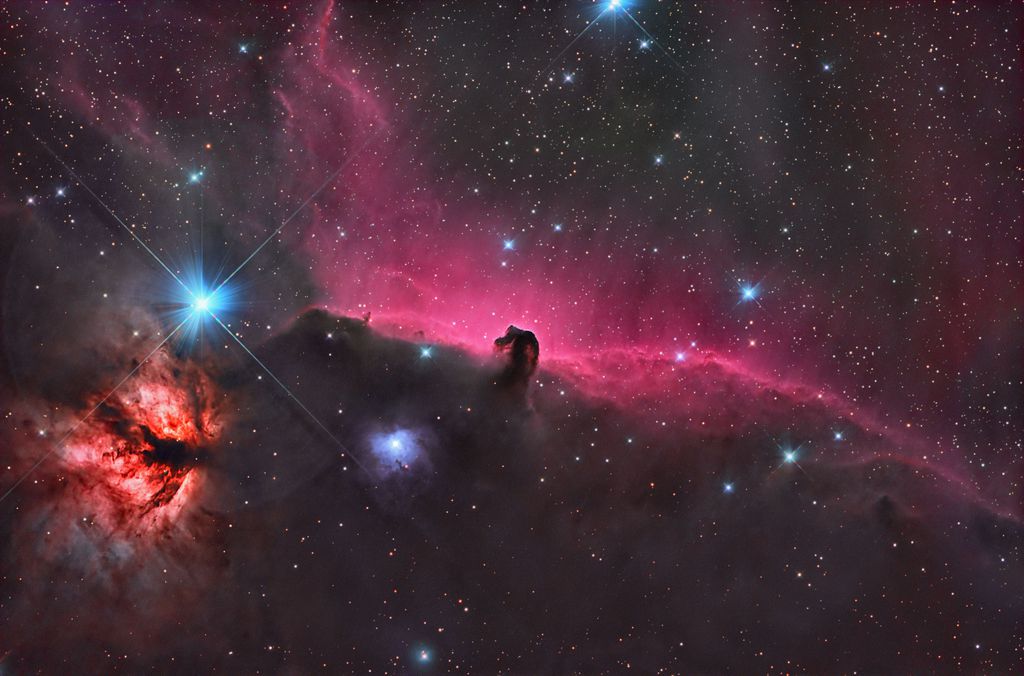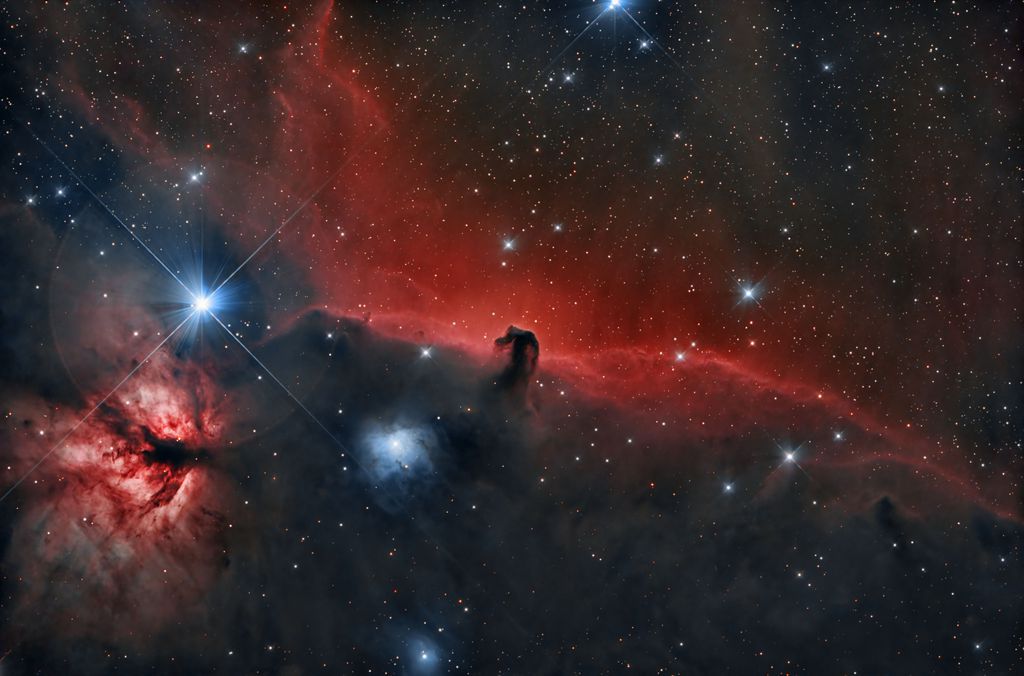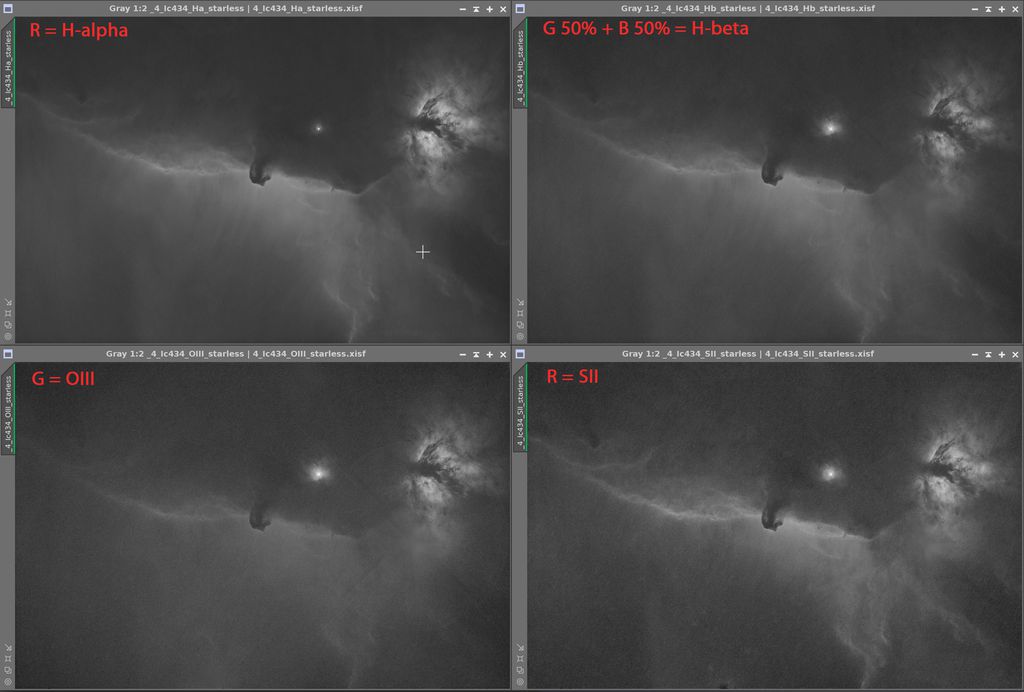Hello everyone,
I've recently added to my Newton 20cm f/4 + ASI2600MC a filter wheel with two 5nm Antlia Dual Band filters, one Ha-OIII and one Hb-SII. Another slot of the FW has an old IDAS LPS-2 (light pollution suppression).
The idea is to acquire a OSC RGB (the LPS filter) and the four bands H-alpha, OIII, H-beta and SII through the two OSC narrowband filters. The RGB is then processed as stand alone and the narrowbands OSCs are split in four monos and then recombined into an aesthetically pleasing image, highlightimg the different emissions and eventually combined with the RGB image (ie, for the stars, color balacing, etc...).
The target image is Ngc2024 (Flame nebula) and Ic434. Nicely framed by the OTA, there are emission nebulae, reflection nebulae, dark structures and bright stars to test anti halo coatings of the filters. Overall the objects are bright in each narrowbands (each filter was exposed with 1 hour integration).
Here are my tests (see below images). I'd like to hear from anybody who has been using similar approaches with these filters and OSC cameras. Basically, the issue is how to best combine into an RGB image the narrowband data either as single mono frames or as OSC. Comments welcomed! Thanks Stefano.
This is an Ha (as Red) HbOIII (Green) HbOIII (Blue) pixel math combination plus RGB stars:

This is an SHO combination plus RGB at 50% with RGB stars using NBRGB combination script

This is just the LPS image.

By splitting the RGB channels of the two dual bands, I created these mono images assuming: 1) H-alpha is only the RED channel of the Ha.OIII dual band, 2) OIII is the GREEN channel of the Ha.OIII dual band, 3) H-beta is a 50-50 blend of the GREEN and BLUE channels of the Hb.SII dual band, 4) SII is the RED channel of the Hb.SII dual band. Monos below are just scren stretched and were combined with different palettes/scripts to get the above images. Of course, by splitting a dual band OSC into the single narrow bands we don't get a "pure" narrow band signal as if shooting with mono cameras and dedicated filters, but the tecnique has the advantage of reducing the overall exposure times.
 |
You cannot like this item. Reason: "ANONYMOUS".
You cannot remove your like from this item.
Editing a post is only allowed within 24 hours after creating it.
You cannot Like this post because the topic is closed.
Hi, I have been doing this for a while (using the same 2 Antlia filters) - there are a couple of good videos on YouTube on how to process the data as SHO (I actually use the Foraxx palette): https://www.youtube.com/watch?v=q9h-Ag7E-iY&t=501s (Antlia) & https://www.youtube.com/watch?v=PEp70iIJjoU&t=457s (James Lamb).
Here's one I recently did of the heart nebula: https://www.astrobin.com/zhoyxk/
And the Lagoon: https://www.astrobin.com/ihr7e3/B/
I've recently purchased a new Player One Ha Oiii filter, as I have had lots of halo issues with the Antlia, but haven't tried the Player One yet.
|
You cannot like this item. Reason: "ANONYMOUS".
You cannot remove your like from this item.
Editing a post is only allowed within 24 hours after creating it.
You cannot Like this post because the topic is closed.
Thats good work Stefano, really nice images.
I'd be interested to hear more about the software used in processing.
Tony
|
You cannot like this item. Reason: "ANONYMOUS".
You cannot remove your like from this item.
Editing a post is only allowed within 24 hours after creating it.
You cannot Like this post because the topic is closed.
Hi all,
I must be missing something here. I also use the ASI2600MC with a single filter, either the Optolong L-Enhance, or the L-Ultimate. The Ultimate is much more narrowband, with each band being 3 nm.
My image do not have the filter haloes (I don't think they do) and I processed the background a bit darker, sacrificing some gas for better contrast. But my total integration time was only 2" 46" and no filter changes.
Here's an image of the same object as above:

Here are two other images, same setup, using refractors, which is why there are no star spikes. The California Nebula was taken with the Esprit 100 ED refractor and the L-Ultimate filter and the Wizard nebula with the Askar 130PHQ refractor and the same filter.
I seem to be getting the results i want by splitting the stretched RGB image into R, G and B and applying linear fit to boost the brightness of the G and B to match the R.
I am not sure I see any advantage in terms of color in using more filters considering I have little opportunity to image frequently due to where I live. Am I missing something?

 |
You cannot like this item. Reason: "ANONYMOUS".
You cannot remove your like from this item.
Editing a post is only allowed within 24 hours after creating it.
You cannot Like this post because the topic is closed.
|
Excellent photos Jerry. Here's an example of mine with a halo issue: https://www.astrobin.com/t7f7hd/D/ - it occurs with bright stars, it's not all the time. Player one markets their filter as 'halo free', and I've seen examples that look good. Agena Astro does mention the Antlia halo issue in their product page (and state that returns will not be accepted due to halo issues): https://agenaastro.com/antlia-alp-t-dual-narrow-band-oiii-ha-imaging-filter-2-mounted.html |
You cannot like this item. Reason: "ANONYMOUS".
You cannot remove your like from this item.
Editing a post is only allowed within 24 hours after creating it.
You cannot Like this post because the topic is closed.
Dan Kohn:
Excellent photos Jerry. Here's an example of mine with a halo issue: https://www.astrobin.com/t7f7hd/D/ - it occurs with bright stars, it's not all the time. Player one markets their filter as 'halo free', and I've seen examples that look good.
That's beautiful Dan. Love the contrast you decided upon.
|
You cannot like this item. Reason: "ANONYMOUS".
You cannot remove your like from this item.
Editing a post is only allowed within 24 hours after creating it.
You cannot Like this post because the topic is closed.
Dan Kohn:
Hi, I have been doing this for a while (using the same 2 Antlia filters) - there are a couple of good videos on YouTube on how to process the data as SHO (I actually use the Foraxx palette): https://www.youtube.com/watch?v=q9h-Ag7E-iY&t=501s (Antlia) & https://www.youtube.com/watch?v=PEp70iIJjoU&t=457s (James Lamb).
Thanks Dan, yes this is similar to what I did, except that I also added a OSC RGB either as stars only or stars plus nebula to improve color balance.
A blend of Hb and OIII monos from the two dual bands shots is a real plus on some emission nebulae.
|
You cannot like this item. Reason: "ANONYMOUS".
You cannot remove your like from this item.
Editing a post is only allowed within 24 hours after creating it.
You cannot Like this post because the topic is closed.
Tony Hopkinson:
Thats good work Stefano, really nice images.
I'd be interested to hear more about the software used in processing.
Tony
Tony, it's all PI using the following steps after calibration:
- blurX
- SPCC
- split the channels in the dual bands OSC
- combine the monos Hb and OII
- RGB combination or pixel math or foraxx or NBRGB combination
- starless with starX
- stretch with GHS and HT
- some LHE
- add the RGB stars
- noiseX
- fine tuning with photoshop
|
You cannot like this item. Reason: "ANONYMOUS".
You cannot remove your like from this item.
Editing a post is only allowed within 24 hours after creating it.
You cannot Like this post because the topic is closed.
Jerry Gerber:
I am not sure I see any advantage in terms of color in using more filters considering I have little opportunity to image frequently due to where I live. Am I missing something?
Jerry, my idea was get a "close to" pure narrowband signal (as I would get from a complete set of NB mono filters) plus RGB saving some imaging time. The dual bands have Ha and OIII, SII and Hb, widely apart and close to nothing in between; emission lines can be easily separated and blended into the desired palette. And then in one shot you get a "pure" RGB from a typical LPS filter. At the end you would use three filters instead of six or seven as an acceptable compromise vs a classic Ha OIII SII L R G B image. As a bonus you get the Hb emission line to blend with OIII (Ic434 for example a powerfull Hb nebula) which is usually overlooked.
|
You cannot like this item. Reason: "ANONYMOUS".
You cannot remove your like from this item.
Editing a post is only allowed within 24 hours after creating it.
You cannot Like this post because the topic is closed.
Stefano Pesci:
Jerry Gerber:
I am not sure I see any advantage in terms of color in using more filters considering I have little opportunity to image frequently due to where I live. Am I missing something?
Jerry, my idea was get a "close to" pure narrowband signal (as I would get from a complete set of NB mono filters) plus RGB saving some imaging time. The dual bands have Ha and OIII, SII and Hb, widely apart and close to nothing in between; emission lines can be easily separated and blended into the desired palette. And then in one shot you get a "pure" RGB from a typical LPS filter. At the end you would use three filters instead of six or seven as an acceptable compromise vs a classic Ha OIII SII L R G B image. As a bonus you get the Hb emission line to blend with OIII (Ic434 for example a powerfull Hb nebula) which is usually overlooked.
That makes sense. If I had the right sky conditions, I'd probably try something similar or maybe even just go completely mono with filters. But I don't and my imaging time is highly attenuated due to wind, clouds and coastal fog. For me the best option, at least for now, is to shoot OSC with one NB filter and continue to learn more about processing and what's possible on that end of things.
|
You cannot like this item. Reason: "ANONYMOUS".
You cannot remove your like from this item.
Editing a post is only allowed within 24 hours after creating it.
You cannot Like this post because the topic is closed.
I got only abut an hour using L-eNhance only. I used the special algorithm for Ha+OIII in Astro Pixel Processor. It is supposed to take better care for the Ha data but leaves the Hb and OIII to normal RGB processing.
As for the L-eNhance, it definitely makes a big halo! I have placed the filter further away from sensor to make halo bigger but weaker. Perhaps I should move it even 30mm more to weaken it more?
Sony a7 full spectrum behind an RC8" with TSRCFlat2
 |
You cannot like this item. Reason: "ANONYMOUS".
You cannot remove your like from this item.
Editing a post is only allowed within 24 hours after creating it.
You cannot Like this post because the topic is closed.
Hi,
I am using ZWO ASI294MC PRO with Optolong L-Enhance and was able to extract separately the bands for Halfa and OIII using the approach described by Dark Sky Geek:
https://www.youtube.com/watch?v=Ie5tzJ8EtZQ
https://www.youtube.com/watch?v=19nKeFPu38s
I believe it is a more scientifically accurate extraction process.
Here is the result for the Crab Nebula RGB -> HOO

You can find more details on my processing workflow and pixelmath formulas for my setup here: https://www.astrobin.com/twt34m/B/ |
You cannot like this item. Reason: "ANONYMOUS".
You cannot remove your like from this item.
Editing a post is only allowed within 24 hours after creating it.
You cannot Like this post because the topic is closed.
to create to post a reply.












